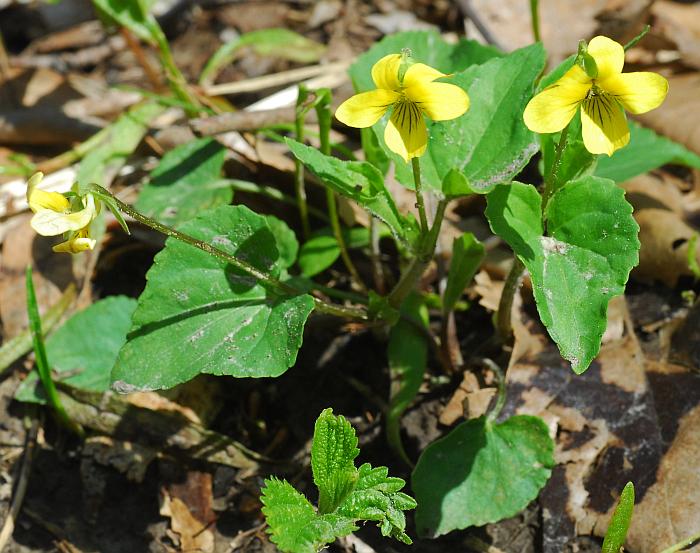Viola pubescens Aiton
Yellow Violet

Native
CC = 5
CW = 3
MOC = 89
© SRTurner
Viola pubescens AitonYellow Violet | |
 |
Native CC = 5 CW = 3 MOC = 89 |
© SRTurner |
|
Family - Violaceae Habit - Perennial forb with a stout, prostrate to ascending rhizome 3-5 mm thick. Stems - Ascending to erect, to 35 cm, sometimes from a spreading base, glabrous below but with some pubescence in distinct vertical lines on stem ridges. Leaves - Leaves alternate and sometimes also basal at flowering, short-to long-petiolate, the petiole to 15 cm long, glabrous or hairy. Cauline leaves with shorter petioles, stipulate. Stipules relatively small and inconspicuous, free from the petiole, unlobed, the margins entire or shallowly and irregularly toothed. Leaf blades 1.5-7.0 cm long, unlobed, ovate to heart-shaped or somewhat kidney-shaped, angled or broadly rounded at the tip, rounded to cordate at the base, the margins evenly and bluntly toothed, the surfaces glabrous or hairy.
Inflorescence - Single axillary flowers. Peduncles sparsely to moderately pubescent, 6-7 cm long, 1.1 mm in diameter. Flower stalks not or only slightly overtopping the leaves (those of the cleistogamous flowers erect or ascending). Flowers - Sepals 3-6 mm long, lanceolate, sharply pointed, the margins sometimes minutely hairy, the basal auricles short and inconspicuous. Corollas 8-12 mm long (except in cleistogamous flowers), the petals oriented forward with arched or outward-curved apical portions, longer than the sepals, yellow, the upper and lateral petals sometimes brownish-tinged on the undersurface, the lateral and especially the lower petals usually with dark purple to brownish purple veins, the lateral petals bearded on the upper surface with mostly knob-shaped hairs, the lowermost petal glabrous on the upper surface, the spur minute (the lower petal often appearing merely pouched), not or only slightly exserted beyond the sepal auricles, relatively stout. Stamens 4, not exserted, typically not visible without dissection of the flower. Style club-shaped, with a capitate, bearded tip. Ovary 1-locular. Placentation parietal. Cleistogamous flowers produced.
Fruits - Capsules 9-12 mm long, narrowly ellipsoid to ellipsoid, 3-valved, green, drying to tan to olive-colored, the surface glabrous or densely woolly. Seeds 2.1-2.4 mm long, brown.
Flowering - March - May. Habitat - Bottomland and mesic forests, bases and ledges of bluffs, streambanks, edges of pastures, shaded roadsides. Origin - Native to the U.S. Lookalikes - None when in flower. Other info. - You can't miss this plant in the wild. Like most violets, it blooms early and shows up well against the dark forest floor. The corolla is yellow and violet-shaped, making for easy identification in the wild. This species is one of a minority of Missouri violets which produce aerial stems. The stipules are mostly entire (not fringed), which distinguishes it from the other common species. The plant is common in forested bottomlands across Missouri, and also throughout most of the eastern half of the continental U.S. except for the far south. Photographs taken in the Ozark Scenic Riverways, Shannon County, MO., 5-24-03, and at Eagle Bluffs Conservation Area, Boone County, MO., 3-27-04 (DETenaglia); also at Engelmann Woods Natural Area, Franklin County, MO, 4-20-2014, Duck Creek Conservation Area, 5-13-2016, along the Katy Trail near Dutzow, Warren County, MO, 4-3-2020, and at Mingo NWR, Stoddard County, MO, 5-23-2022 (SRTurner). |